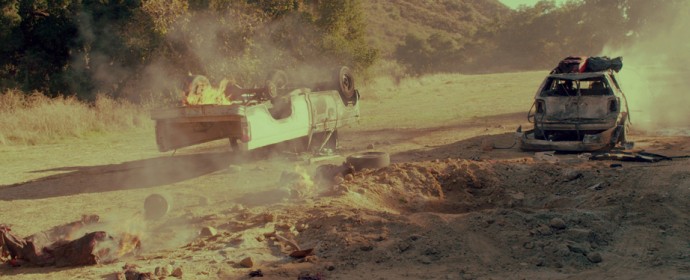
Odds & Ends III – Drones and Warfare
The programme at The Mosaic Rooms on Cromwell Road caught my eye and reminded me of the developing body of work that critically engages with our use of drones in warfare – George Barber, James Bridle, Harun Farocki and Omer Fast spring to mind (see below for examples). Mosaic Rooms have an exhibition – Mouths At The Invisible Event – of David Birkin‘s work “centred around censorship, spectatorship and the legal and linguistic frameworks underpinning war”, and an related programme of films and lectures:
28 January, screening – Tonje Hessen Schei‘s documentary DRONE “looks at the CIA drone war. It follows people on both sides of the drone technology. The unique access to drone victims in Waziristan is juxtaposed to drone pilots who struggle to come to terms with the new warfare.”
Details and booking here.
5 February, panel discussion – Unmanned, reflecting on the growing use of armed drones in modern warfare. Participants to include Julian Stallabrass and Chris Woods.
Details and booking here.
11 February, screening – Harun Farocki‘s War At A Distance
Details and booking here.
Harun’s four-part series Serious Games (2009 – 2010) also provides a counter-point to War At A Distance and Omer Fast’s 5,000 Feet is the Best (see below).
A FEW MORE WORKS REFLECTING ON THE USE OF DRONES
Omer Fast‘s 5,000 Feet is the Best (2011) can be found in full here (courtesy of the artist and GB Agency).
Still for 5,000 Feet is the Best (courtesy of the artist and GB Agency).
George Barber‘s Freestone Drone (2013)
Courtesy Waterside Contemporary.
Here‘s a link to the 2013 exhibition at Waterside Contemporary. Sukhdev Sandhu’s Sight and Sound review of the Waterside exhibition (link at the bottom of the Waterside webpage above) is interesting: “New conceptual associations – like playing on the meaning of drone (think ‘thankless labour’) – are overlaid with cinematic links to the French New Wave. The film draw on Georges Delerue’s richly emotional music for Godard’s Le Mepris, uses black-and-whit stills evocative of Marker’s La Jetee and borrows Last Year in Marienbad’s story line of a woman repeatedly telling a man that they’ve never me before. By the end, the drone-as-human conceit has stopped being absurd and has begun to feel weirdly melancholic, saturated with sadness.”
James Bridle‘s Dronestagram: The Drone’s Eye-view (2012 – ongoing).
“Wadi al Abu Jabara. Beit al Ahan. Jaar. Dhamar. Al-Saeed. Tappi. Bulandkhel. Hurmuz. Khaider khel.
These are the names of places. They are towns, villages, junctions and roads. They are the names of places where people live and work, where there are families and schools. They are the names of places in Afghanistan and Yemen, which are linked by one thing: they have each been the location of drone strikes in the past couple of months. (The latest was in the early hours of November 7th, the night of the US election.)
They are the names of places most of us will never see. We do not know these landscapes and we cannot visit them.
What can reach them are drones… [read more here]”
Follow the project on twitter here or on tumblr here or on instagram here.
James’ Drone Shadow series (2012 – ongoing) is an eerie reminder of what might be overhead right now…
Courtesy of the artist.
And then there’s the excellent Tim Wilcox curated exhibition – Sensory War – at Manchester Art Gallery to 22 February 2015 (details here).

